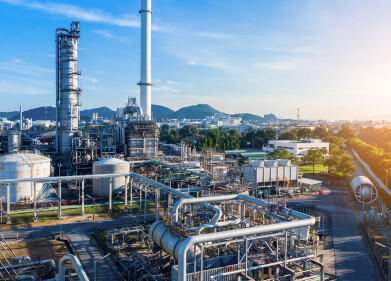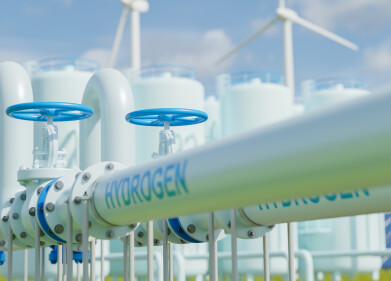-
 Canada has a long history as an energy exporter
Canada has a long history as an energy exporter -
 The Athabasca river, Alberta Canada
The Athabasca river, Alberta Canada
Fuel for Thought
Hydrogen from in-situ underground gasification of oil reserves
Aug 13 2021
Author credit - Stephen B. Harrison, Allegra Cresswell-Turner and S. Hamid Yousefi, sbh4 consulting
To accelerate the energy transition and reduce carbon dioxide (CO2) emissions, fossil fuels must be replaced with clean energy carriers, such as hydrogen. If SMR technology is combined with CCS (Carbon Capture and Storage), blue hydrogen is produced. Another clean energy source is green hydrogen, which can be produced through electrolysis of water using renewable electricity. However, there is a constant drive to find technologies that can produce low cost, low carbon hydrogen.
It is possible to use underground hydrocarbon resources to produce hydrogen through in-situ gasification. This technology has the potential to be commercialised internationally, due to the large volumes of oil resources globally. Instead of extracting crude oil from the underground fossil energy resources, in-situ gasification in the underground fossil fuel reservoir can be applied to create low carbon hydrogen.
The underground in-situ gasification processes
During the in-situ gasification process, the reservoir should be heated either through the application of an oxidizing agent or use of downhole equipment. In the first method, oxygen is injected into the oil reservoir, leading to a chemical reaction that oxidizes water and hydrocarbons and releases heat (in-situ combustion process). When the temperature in the underground reservoir reaches 350 °C, water and heavier hydrocarbons will split and hydrogen and carbon oxides will then be produced.
The second method is reservoir heating, using a downhole antenna in the reservoir to generate radio-frequency electromagnetic waves. Both methods result in forms of thermolysis, which is the thermal decomposition of chemicals. During hydrogen production it is possible to use the generated heat to produce steam and generate electricity.
To produce pure hydrogen, gas separation is achieved by installing a downhole membrane, which can separate hydrogen from carbon oxides. Hydrogen is extracted from the production well and since the carbon monoxide and carbon dioxide gases and other hydrocarbons remain underground, the process is very clean.
This membrane is a physical barrier allowing selective species transport and is based on diffusion velocity difference of hydrogen and carbon oxides. The lower diffusion rate gases, carbon monoxide and carbon dioxide, remain at the feed side and hydrogen passes through the membrane.
Proton Technologies are conducting a demonstration project using a patented palladium-alloy membrane, which creates the appropriate mass transfer conditions. One of the areas under close investigation during the demonstration project is the long-term security of underground CO2 storage, due to the carbon monoxide and CO2that is formed as a by-product of the gasification. The downhole membrane efficiency for hydrogen separation is also being evaluated.
From fossil fuels to clean energy
In the long term, Proton Technologies intends to use in-situ underground gasification to monetize wet bituminous hydrocarbon reserves by producing cheap and sustainable hydrogen at scale. Since water (H2O) is a hydrogen carrier and contributes to enhanced hydrogen production during the underground gasification, reservoirs with high water saturation are the best candidates for in-situ gasification when hydrogen is the target energy vector.
Whilst wet reserves are ideal, this technology is broadly applicable to different kinds of oil and gas resources. As an example, in the Middle East, there are many stranded reserves in Kuwait which have been disregarded for conventional extraction due to their heavy, wet nature. With this new hydrogen production technology, these reserves may be seen as economically viable clean energy resources.
Low cost and low carbon: the potential of underground in-situ gasification
One significant benefit of underground in-situ gasification, is that it uses the subsurface reserves as a huge and controllable chemical reactor, thus avoiding the capital cost of building a major reactor above the surface. Furthermore, it leaves carbon monoxide and carbon dioxide gases in the reservoir, meaning that it operates with very low overall carbon intensity.
Another advantage is its capability to produce hydrogen at very large-scale. Calculations for a hypothetical heavy oil reservoir with 32 million tonnes of remaining oil, show that the production of 500 tonnes of hydrogen per day could be possible*. Previously, the biggest disadvantage of clean energy has been its cost. This method could therefore help to remove that obstacle and could accelerate the transition to carbon-neutrality.
References
* Yu, M., K. Wang, and H. Vredenburg, Insights into low-carbon hydrogen production methods: Green, blue and aqua hydrogen. International Journal of Hydrogen Energy, 2021. 46(41): p. 21261-21273.
Digital Edition
PIN 25.5 Oct/Nov 2024
November 2024
Analytical Instrumentation - Picturing Viscosity – How Can a Viscometer or a Rheometer Benefit You? - Sustainable Grease Formulations: Evaluating Key Performance Parameters and Testing Method...
View all digital editions
Events
Nov 18 2024 Rome, Italy
Nov 19 2024 Singapore
Nov 19 2024 Shanghai, China
Nov 20 2024 Karachi, Pakistan
Nov 20 2024 Maputo, Mozambique


















